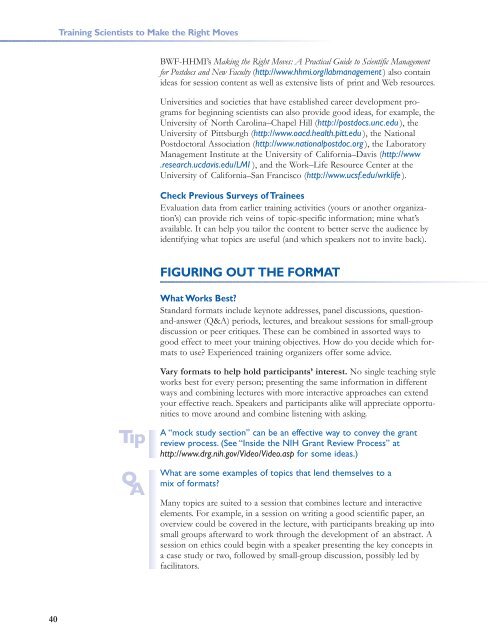Training Scientists to Make the Right Moves - Howard Hughes ...
Training Scientists to Make the Right Moves - Howard Hughes ...
Training Scientists to Make the Right Moves - Howard Hughes ...
You also want an ePaper? Increase the reach of your titles
YUMPU automatically turns print PDFs into web optimized ePapers that Google loves.
<strong>Training</strong> <strong>Scientists</strong> <strong>to</strong> <strong>Make</strong> <strong>the</strong> <strong>Right</strong> <strong>Moves</strong><br />
BWF-HHMI’s Making <strong>the</strong> <strong>Right</strong> <strong>Moves</strong>: A Practical Guide <strong>to</strong> Scientific Management<br />
for Postdocs and New Faculty (http://www.hhmi.org/labmanagement ) also contain<br />
ideas for session content as well as extensive lists of print and Web resources.<br />
At a Glance<br />
“”<br />
QA<br />
Universities and societies that have established career development programs<br />
for beginning scientists can also provide good ideas, for example, <strong>the</strong><br />
University of North Carolina–Chapel Hill (http://postdocs.unc.edu ), <strong>the</strong><br />
University of Pittsburgh (http://www.oacd.health.pitt.edu ), <strong>the</strong> National<br />
Postdoc<strong>to</strong>ral Association (http://www.nationalpostdoc.org ), <strong>the</strong> Labora<strong>to</strong>ry<br />
Management Institute at <strong>the</strong> University of California–Davis (http://www<br />
.research.ucdavis.edu/LMI ), and <strong>the</strong> Work–Life Resource Center at <strong>the</strong><br />
University of California–San Francisco (http://www.ucsf.edu/wrklife ).<br />
Check Previous Surveys of Trainees<br />
Evaluation data from earlier training activities (yours or ano<strong>the</strong>r organization’s)<br />
can provide rich veins of <strong>to</strong>pic-specific information; mine what’s<br />
available. It can help you tailor <strong>the</strong> content <strong>to</strong> better serve <strong>the</strong> audience by<br />
identifying what <strong>to</strong>pics are useful (and which speakers not <strong>to</strong> invite back).<br />
At a Glance<br />
At a Glance<br />
“”<br />
QA<br />
At a Glance<br />
FIGURING OUT THE FORMAT<br />
What Works Best?<br />
Standard formats include keynote addresses, panel discussions, questionand-answer<br />
(Q&A) periods, lectures, and breakout sessions for small-group<br />
discussion or peer critiques. These can be combined in assorted ways <strong>to</strong><br />
good effect <strong>to</strong> meet your training objectives. How do you decide which formats<br />
<strong>to</strong> use? Experienced training organizers offer some advice.<br />
Chapter One<br />
Vary formats <strong>to</strong> help hold participants’ interest. No single teaching style<br />
works best for every person; presenting <strong>the</strong> same information in different<br />
ways and combining lectures with more interactive approaches can extend<br />
your effective reach. Speakers and participants alike will appreciate opportunities<br />
<strong>to</strong> move around and combine listening with asking.<br />
A “mock study section” can be an effective way <strong>to</strong> convey <strong>the</strong> grant<br />
review process. (See “Inside <strong>the</strong> NIH Grant Review Process” at<br />
http://www.drg.nih.gov/Video/Video.asp for some ideas.)<br />
Chapter One<br />
What are some examples of <strong>to</strong>pics that lend <strong>the</strong>mselves <strong>to</strong> a<br />
mix of formats?<br />
Many <strong>to</strong>pics are suited <strong>to</strong> a session that combines lecture and interactive<br />
elements. For example, in a session on writing a good scientific paper, an<br />
overview could be covered in <strong>the</strong> lecture, with participants breaking up in<strong>to</strong><br />
small groups afterward <strong>to</strong> work through <strong>the</strong> development of an abstract. A<br />
session on ethics could begin with a speaker presenting <strong>the</strong> key concepts in<br />
a case study or two, followed by small-group discussion, possibly led by<br />
facilita<strong>to</strong>rs.<br />
40
















